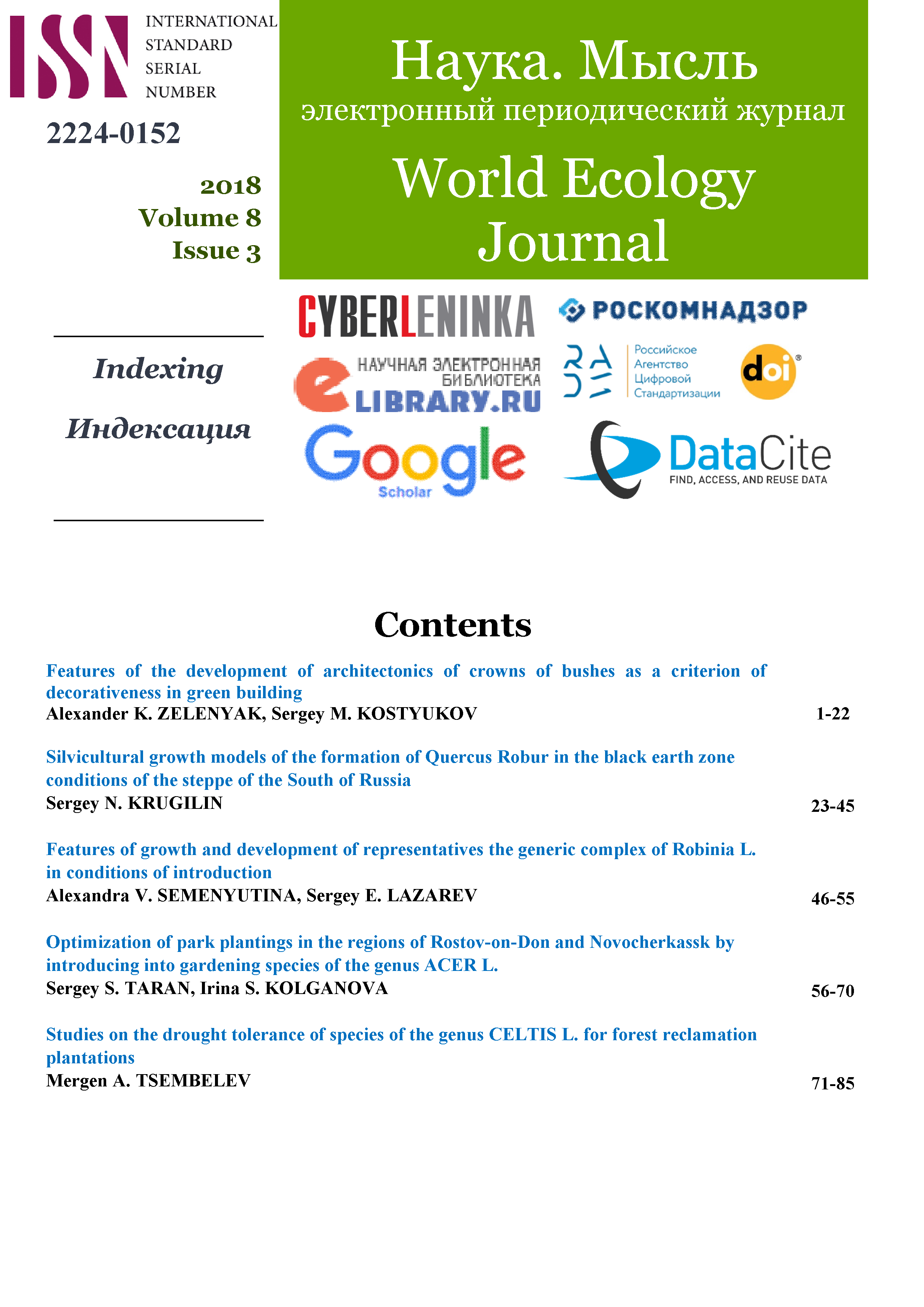Лесоводственные модели роста и формирования Quercus robur в условиях черноземной зоны степи Юга России
DOI:
https://doi.org/10.25726/NM.2019.49.29.002Ключевые слова:
Рост дуба черешчатого, программированное выращивание лесных культур, ритмика роста главной и вспомогательной породы, тип смешения, формирование насаждений.Аннотация
В пределах территории европейской части России зона степей занимает более 60 млн. гектаров. Степи представлены на Южном Урале, на Волге, на Дону, в Предкавказье, в Заволжье. Выращивая степные насаждения, специалисты всегда сталкиваются с большими проблемами, в первую очередь связанными с природными условиями. Именно природные условия обуславливают особые подходы в проектировании, создании и выращивании лесных культур.
Одной из основных древесных пород в условиях черноземной зоны Юга России является дуб черешчатый. При выращивании культуры дуба возникает много второстепенных вопросов, касающихся выбора сопутствующих пород, схем смешения и размещения, густоты в разные возрастные периоды.
Другими словами, важным моментом при формировании искусственных насаждений дуба черешчатого является информация о лесоводственных моделях. Ведь, именно знание модели поведения насаждений в разные возрастные периоды позволит вырастить продуктивные и устойчивые насаждения, которые в полной мере будут выполнять отведенную функцию в нашей степной зоне – защитную!
Целью представленной работы является анализ хода роста дуба черешчатого в смешении с разными древесными и кустарниковыми породами и разработка их лесоводственных моделей применительно к условиям черноземной зоны Юга России.
Библиографические ссылки
2. Zhezhkun A.M. Dubovі tree staniskhіdnogo polіssya: formavannya, camp, productiveness Науковий вісник НУБіП України. Seriya: Lіs_vnittvot more decorative gardening. 2013.№187-2. Pp. 49-58.
3. Kruzhilin S., Baranova T. Principles of modern approaches to forest vegetation zoning, forest types and growing conditions World Ecology Journal. 2017. No. 7 (7). Pp. 29-34. URL: https://doi.org/https://doi.org/10.25726/nmenzh.v7i7.6
4. Kruzhilin S., Ishchenko O., Bagdasaryan A. Monitoring of oak forests in the conditions of the Lower Don (on the example of Donleskhoz) World Ecology Journal. 2017. No. 7 (7). Pp. 35-39. URL: https://doi.org/https://doi.org/10.25726/nmenzh.v7i7.7
5. Kruzhilin S.N. Cultivation of pedunculate Oak trees using the rocker method of mixing in the conditions of the Rostov region Agroforestry in the 21st century: state, problems, and prospects. Fundamental and applied research: materials of the Intern. scientific-practical conf. Volgograd, 2015. P. 142-146.
6. Kruzhilin S.N. Growth of pedunculate oak in forest cultures, created using different types of mixing in the conditions of the Lower Don: dis. ... Cand. S.-H. sciences. Novocherkassk, 2008.
7. Kruzhilin, S.N. Regularities of growth and formation of stands Quercus Robur in the steppe conditions. Modern science: current problems of theory and practice. Series: Natural and Technical Sciences. 2014. № 7-8. Pp. 75-78.
8. Kruzhilin, SN. Ecological stability of pedunculate oak in the conditions of the Lower Don Nauka. Think. 2014. №1. Pp. 37-39.
9. Kulygin, A.A., Revyako, I.I., Kruzhilin, S.N. Mixed oak plantations in the Don steppe Forestry. 2004. №2. Pp. 38-39.
10. Manaenkov A.S., Kostin M.V., Shkurinsky V.A. The current state and the possibility of growing industrial oak trees on the complex soils of dry steppe and semi-desert. Vestnik Volga Region State Technological University. Series: Forest. Ecology. Nature use. 2012. №2 (16). Pp. 12-19.
11. Semenyutina A.V. Dendroflora of forest melioration complexes: monograph. Volgograd: VNIALMI, 2013. 266 p.
12. Taran S.S., Matvienko E.Yu., Kruzhilin S.N. Patterns of growth and formation of plantations with the participation of Pinus Sylvestris and Pinus Pallasiana in the conditions of Lower Don Reputiology. 2017. №1 (43). Pp. 19-26.
13. Troitsky V.M., Troitskaya M.S., Kiryushin N.O., Kruzhilin S.N. Programmed cultivation of artificial plantations in the arid climate of the Rostov region. International Student Scientific Journal. 2015. №2-3. Pp. 379-380.
14. Kruzhilin S.N., Taran S.S., Semenyutina A.V., Matvienko E.Yu. Growth peculiarities and age dynamics of the Quercus Robur L. formation in steppe region conditions. Kuwait Journal of Science. 2018. V. 45. No. 4. P. 52-58.




